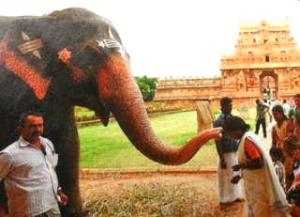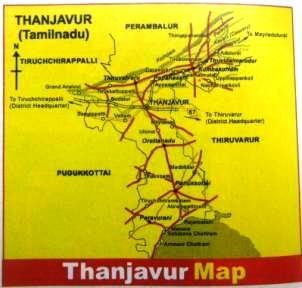If you miss Thanjavur, you miss one among those greatest creations of man!
Thanjavur town opens its eyes everyday before the actual sun rise. On either side of streets you find a lot of people selling jasmine flowers. You can take any an auto rickshaw or a private bus; you will surely find a picture of Thanjavur Brihadeeswaran and a jasmine garland worn to him. While walking in the early mornings through the jasmine fragrant streets towards the temple your mind will surely be lifted light by the spiritual atmosphere and devotion towards Brihadeeswaran. Through loudspeakers you can hear devotional songs of Sirkazhi Govindarajan and many other devotional singers.
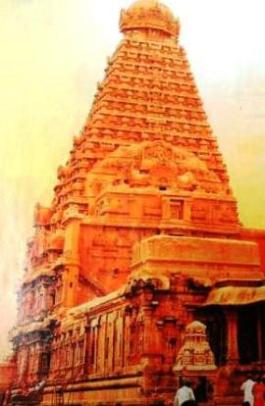
This temple is the masterpiece of Chola art
You will be surprised to know that this marvelous piece of art was completed within 7 years since its construction started. It was started in 1003 AD and completed in 1010 AD taking exactly 6 years and 275 days for completion. Prominent king among Chola kings, Raja Raja Chola constructed this temple with the kind co-operation of his subjects. Thus his wish to build a huge Siva temple was fulfilled in the year 1010. After Chola reign, Nayaks and Marathas also ruled the state adding their own shades and symbols to the temple architecture. There is a big fort built around the temple and deep pits beneath it. Once those pits were filled with crocodiles, not now. When you enter the temple it gives a fort appeal. The Vimana (temple tower) is built on a single granite stone and has 216 feet height.
Vellayamma – the elephant that blesses people
The temple has two main towers (gopuram). First one is Keralanthakan main door and second one is Rajarajan main door. The first one was built after the construction of the main temple. When the Kerala king Bhaskara Ravi Varma was defeated by Cholas this tower was built by them. When you enter Rajarajan tower, you will be welcomed by a female elephant. Her name is Vellayamma. If she blesses you by placing her trunk on her head it’s considered to be a good omen. But she is a trained elephant. If you place coin or rupee in your hand, she blesses you fast and very soon she will pass the money to her mahout who is standing nearby. More than belief, curiosity to touch the elephant attracts kids towards her.
Om Vighneswaraya Namah
You should go to Ganapathi temple first before going inside the main temple. You can see two Ganapathi shrines placed face to face inside the gopuram (tower). Pray before Ganapathi placed at left and go inside. When you leave the temple, you should pray before Ganapathi placed at the right side. Though the first gopulam is the bigger one, second one will make you wonder for its architecture. Stone curvings of that gopuram tell stories of Siva-Parvathy marriage, Markandeyan-Siva story, Kiratharjuneeyam and many more. When you enter the second gopuram and see those story telling curving, you will surely praise those hands behind these pieces of works. Periya Kovil (Main temple) is 200 feet high and it’s the master piece of painting, sculptures, architecture and engineering.
Nandi in front of the temple
Nandi (Sacred bull) – Siva’s vehicle is present in front of the temple, as common in all Siva temples. Nandi carved from a single stone is16 feet long and 13 feet high and on the left side inside the temple is Amman coil (temple of Goddess). Nandi stays on the 16th stone tower known as ‘Kal Mandapam’ in Tamil. This tower was built by Nayaks in the 16th century. Each pillar says the stories of Saiva beliefs. In front of Nandi mandapam is Khestradwajam. Pray before the flag post before entering the temple.
How the temple looks from inside
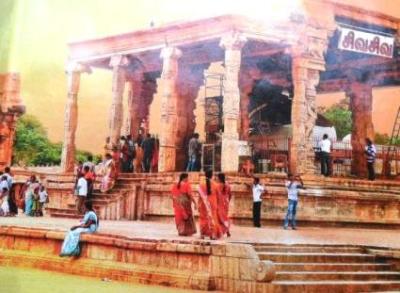
Secret behind names
Thanjavur is known as ‘Nellara’ (rice bowl) of Tamil Nadu. Farmers of Thanjavur give offerings to temple to get rains and prosperous output.
There are many legends behind the name ‘Thanjavur’. First one is like this. Once upon a time there was an asura named ‘Thanchan’ who devastated the whole place and caused miseries to the residents. Hearing the devotees’ prayers Lord Vishnu killed him in this place. But Vishnu granted Thanchan’s wish that this place should be known in his name after his death. Thus Thanjavur was blessed with that name, says one story.
Another story is related with refugees from North. ‘Thanjai’ in Tamil means refugee. Thanjavur is said to be the refugee camp of people who fled from North towards South due to life threat from battles.
Name of the temple ‘Thanchai Peruvudayor Kovil’ was changed to Brihadweswara temple during the reign of Marata kings. ‘Brihadweswara’ is a Sanskrit name. When the temple was built there was no separate ‘kovil’ for Periya Nayaki (Goddess Parvathy). A temple was built for her in the 13th century.
Thanjavur paintings - before you reach before Lingaraja
You need to pass through three towers (madapam) to reach the main shrine – Aradhana Mandapam, Mukha Mandapam and Maha Mandapam. Thanjavur paintings – the masterpiece of Chola art are drawn on walls on the either sides of corridors of Aradhana Mandapam. These paintings are nothing less than great Ajantha paintings. But in dark corridors, it’s not possible to see them. You need not feel despair; exact copy of these paintings are placed in Thanjavur art gallery, just near the temple.
Let me tell you how those paintings were done 1000 years back. It’s believed that painting is done by lime stone plastering on granite and before it dries well and becomes set, artists draw pictures on it and paint it well. Precious stones have also been used for decorating those paintings and most of them depict the cultural heritage and social life of that period. They include characters of Hindu mythology as well as saints and gold folds have also been used for enriching their beauty. Each painting has 15 inch length and 10 inch width and each picture had withstand the passing time and still looks young as if they have born just a few moments ago. Those pictorial art forms are surprising treats for our eyes and they stood there young witnessing many seasonal changes of nature till now. They are really wonderful creations of man kind, no doubt.
81 Karanas of Natyashstra visualized here
If we walk through temple corridors it looks as if it’s the competition between painting and sculptures. We can’t determine which one is the best.
Bharat Saint’s Natyasastra consist of 108 Karanas meaning ‘doing or movements of hands and legs’, of which 81 are visualized here in the form of sculptures done on granite rocks. Most surprising is that place is reserved to fill the remaining Karanas and still now that space is vacant.
When you reach in the front of Rajarajeswaramudayon
When you move a little further, you will hear only ‘Panchakshari Mantra’ and long queue of devotees.
“Brahmamurari Surarchitha Lingam
Thalpranamaami Sadasiva Lingam”
Including 108 Siva lingas of the temple, more than 250 Siva shrines are present in the temple. It appears as if you are standing in front of a magical world when the main shrine is just near you. The artistic minds of Chola kings are imprinted in the main Lingam too; it is 12 feet high.
Now to Dhakshinamurthy shrine
When you climb down the steps chanting Siva prayers, your mind will be filled with eternal joy and of course, your next destination is Dhakshinamurthy shrine. The gigantic size shrines of Sun (Soorya) and Moon (Chandra) together known as Koshtamurthy will make you wonder for sure. Even the shrines of Asktadik Paalakas (those who protects the eight directions of earth) – Indra, Varuna, Agni, Eesanan, Vayu, Niryathi, Yaman and Kuberan have a normal human size. You should complete the prayers by praying before the temples of moorthies –Chandikeswara, Muruga (Subramaniya), Ganesha, Anganeya and Varaha and later before Periyanayaki (Parvathy). Then only you should leave the temple.
The Vimana (Gopuram) never casts shadows
The height of single granite stone with 216 feet height itself is a great wonder. It’s believed to be the first granite construction of the world. The Kumbam (apex) of this gigantic structure has a peculiarity. Even at noon, it never casts shadows. The vasthu method of falling its shadow in the tower’s ‘prakaaram’ was adopted for its construction a millennium back where light and darkness get opportunity to tell stories together.
Vimana’s base is a 96 feet square piece. There are 8 shikharams (steps/branches) on its top. Above those 8 steps, stands the apex (makudam) at 200 feet height and its weight is 81.284 tones! How was this single stone placed on the top of the tower of 200 feet height? Is it some super natural power? Very far away from human imaginations!
Granite was not abundant in Thanjavur when the temple was built. They were brought even from 50 km distance. That shows the dedication and devotion of workers and associated people a millennium back. The 81 tone stone needed for the apex was brought from Sharapallam, a place 7 km away from Thanjavur. A slide path was laid from earth surface to tower top using soil to take that 81 tone weighted stone to the Vimana top. It’s believed that new layers of earth were laid every time when the works of lower parts of tower are completed. This process continued till the whole tower was constructed and earth layers reached the top to place the single granite stone on the Vimana base.
It’s not just the hard work of thousands of workers or funds allocated by the Chola kingdom, but the engineering skills of those ancient days too make us astonish today! Another significant peculiarity of Thanjavur architecture is ‘the expressive sculptures’. When we stare at those beauties we get a clear sketch of ornaments and social life of those prosperous days of Indian splendid culture. We can now imagine that hundreds of beauties might have turned models while those beautiful carvings have been sculptured!
At least 2 hours are needed if you want to enjoy the temple architecture fully. When you are passing through those monuments, a society, a millennium year old is being unfolded before you taking you to a mesmerizing world of creativity and imagination.
Around Thanjavur what else?
Just near Thanjavur Brahadeswara temple is the Thanjavur palace built by Nayaks in the 15th century. In the Sarawathy Mahal of this palace 3 lakh palm leaves are kept. In the royal museum associated with the palace, costumes, ornaments and weapons of that old era are also kept. Entry time is from 10 am to 5.30 pm. Rajarajan museum is just beneath Rajarajan Manimandapam in the main town. You can see photos of Thanjavur paintings here.
Silk and dolls – other signatures of Thanjavur
Once you leave the temple praying before the Ganapathy shrine (I have specified about that Ganapathy shrine at the beginning) you can go through other traditional visuals of Thanjavur town. Thanjavur Veena (a musical instrument), silk sari and Thanjavur painting that is also popularly known as Calendar art are the most famous among those signatures.
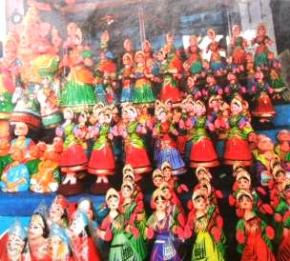
Many shops are there that draw Thanjavur paintings in calendar art style. But you need to give order earlier. At least 10 days are needed to complete a single piece. 20 inch painting costs around 3000 rupees. A special surface is made on plywood and used for painting.
Now let me give a small note about Thanjavur Veena. Now demands are workers are less for this traditional piece of music. Wood of jack fruit tree without any damages is used for making veena. If a tree is fixed, workers will go there and cut the wood as per desired dimensions. It takes at least one month to make a hollow in the wood and complete the work. Veena made from a single piece of wood is most expensive and it may cost up to 30,000 rupees. If veena is made combining different woods, it’s called ‘Ottu Veena’ and it costs 9000 only. Now only 50 families are left in Thanjavur who make this traditional veena and they are doing so, only to follow traditional principles though they don’t get a good profit from veena making. Perhaps after a few decades people may leave this instrument for ever if same sound can be produced with keyboard without any difficulty!
Thanjavur is famous of silk too! Is it possible to identify a good piece of silk? Just draw a thread from the woven silk sari and fold it several times to make it thick. Then show it to the flame. It won’t catch fire easily. Fire swallows it only slowly and it emits the smell of burning hair. It’s the original silk. Synthetic silk catches fire easily and it doesn’t have the smell of burning hair. Now closely examine the sari from which the single thread was drawn. It has not left even a single trait that a thread has been pulled out. Not even a single folding! That’s the peculiarity of Thanjavur silks. If a thread is drawn from a duplicate silk sari or machine woven sari, it will be noticed easily. Also you can see marks there. Let me tell you the reason behind it. In power handlooms, needles are used for weaving silk cloth. But in the case of traditional loom, minute layers taken from green bamboo are used for weaving and you can fit 3 such bamboo layers in a handloom in the place of a single needle of a weaving machine, thus increasing the number of threads in a sari weaved using traditional handloom. Also, threads are weaved so closer comparing machine looms, almost 3 times. That’s the reason why traditional handlooms are so special, though it takes more time to weave a sari.
Thanjavur – Travel information
Thanjavur temple is situated in Trichi route and is 322 km away from Chennai. If you are starting from Ernakulam, Kerala, Karaikal Express train starting from Ernakulam at 10 pm reaches Thanjavur at 9 am. From Trichi, it’s 65 km. It’s the nearest airport too. Bus service is available from Trichi to reach the temple. You can visit the temple in between 6.30 am and 8.30 am. The temple remains closed from 12.30 pm to 3 pm.
Like it on Facebook, Tweet it or share this article on other bookmarking websites.

